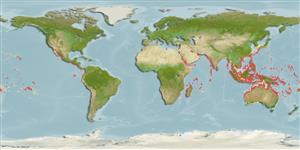Holothuroidea |
Synallactida |
Stichopodidae
Environment: milieu / climate zone / depth range / distribution range
Ecology
Benthic; depth range 0 - 30 m (Ref. 81020). Tropical
Indo-West Pacific.
Length at first maturity / Size / Weight / Age
Maturity: Lm ? range ? - ? cm Max length : 55.0 cm TL male/unsexed; (Ref. 92930)
Maximum depth from Ref. 107901. Occurs in lagoons (Ref. 80735). Grazes on organic materials (Ref. 800). Associated with coral communities. Conceals itself in crevices and overhangs (Ref. 129602).
Life cycle and mating behavior
Maturity | Reproduction | Spawning | Eggs | Fecundity | Larvae
Members of the class Holothuroidea are gonochoric and have only one gonad. Spawning and fertilization are both external and some exhibit brooding. Life cycle: Embryos develop into planktotrophic larvae (auricularia) then into doliolaria (barrel-shaped stage) which later metamorphose into juvenile sea cucumbers.
MarineSpecies.org 2050 MarineSpecies.org. http://www.marinespecies.org/index.php (Ref. 3477)
IUCN Red List Status
(Ref. 130435: Version 2025-1)
CITES status (Ref. 108899)
Not Evaluated
Not Evaluated
Threat to humans
Harmless
Human uses
Fisheries: commercial
| FishSource |
Tools
More information
Population dynamicsGrowth
Max. ages / sizes
Length-weight rel.
Length-length rel.
Length-frequencies
Mass conversion
Abundance
Life cycleReproductionMaturityFecunditySpawningEggsEgg developmentLarvae PhysiologyOxygen consumption
Human RelatedStamps, coins, misc.
Internet sources
Estimates based on models
Preferred temperature
(Ref.
115969): 24.9 - 29.3, mean 28.7 (based on 2274 cells).
Fishing Vulnerability
Moderate vulnerability (42 of 100).
Price category
Unknown.
